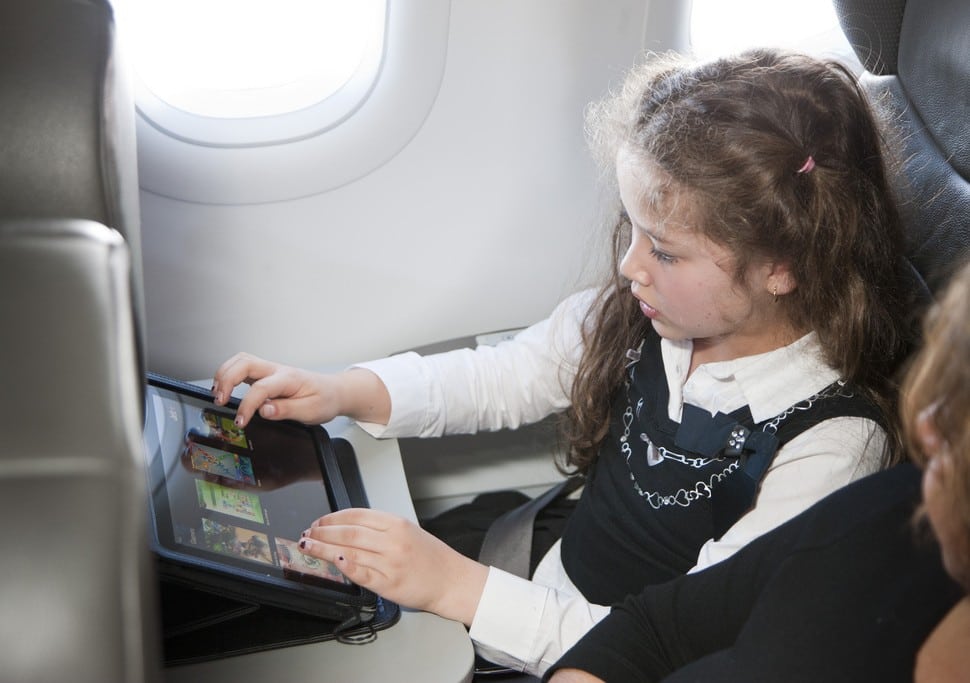This time next year we may not have to listen to constant complaints from passengers forced to stow their iPads and Kindles during takeoff and landing. The committee established by the U.S. Federal Aviation Administration to study the use of personal electronic devices (PEDs) on planes is two weeks into its study what effect 200+ iPod touches or Nooks could have at all stages of a flight.
“Current FAA regulations require an aircraft operator to determine that radio frequency interference from PEDs is not a flight safety risk before the operator authorizes them for use during certain phases of flight,” the FAA stated in the announcement about the committee’s first meeting. “The group’s goal is to help operators decide if they can allow more widespread use of electronic devices in today’s aircraft and make sure tomorrow’s aircraft designs are protected from interference.”‘
The committee will not consider cellphone use at all, leaving that in the hands of the Federal Communications Commission, which is responsible for regulation of the radio spectrum. Currently, most airlines stick to the 10,000 foot rule: Any use of PEDs below that altitude is not allowed.
The 25 committee members, below, are split between airline executives, user experience consultants, representatives from electronics companies, airline crew, passenger advocates, and safety experts.
Some of the committee members make for awkward seating at the dinner table. Douglas Kidd, the Executive Director of the National Association of Airline Passgers, will need to get along with the Transportation and Security Administration’s Jim Klipp, despite Kidd’s outspoken attacks on the TSA.
Bill de Groh of the Air Line Pilots Association can perhaps explain what it’s like to use an iPad in the cockpit during takeoff, and Dinkar Mokadam of the Association of Flight Attendants can discuss how it’s easy to check passenger manifests from a Galaxy Tab while strapped in the jump seat.
Holding all the pieces together is the committee chair Kirk Thornburg, whose day job as Delta Air Lines’ Managing Director for Aviation Safety and Assurance. Thornburg has a long career in aviation safety, serving previously at AirTran, Southwest, and Northwest Airlines.
| Name | Company |
|---|---|
| Peter Enders | Airbus |
| Susan Beard | Rockwell Collins |
| Stacey Bechdolt | Regional Airline Association |
| Greg Bowles | General Aviation Maintenance Association |
| Ken Brady | Thales Avionics |
| Michael Childers | Lufthansa Systems |
| Chuck Cook | JetBlue |
| Nikki Cuban | OnAsset |
| Bill de Groh | Air Line Pilots Association International |
| David C. Hartze | Boeing Commercial Airplanes |
| Douglas Johnson | Consumer Electronics Association |
| Douglas Kidd | National Association of Airline Passengers |
| Jim Klipp | Transportation Security Administration |
| Julius Knapp | Federal Communications Commission |
| Billy Martin | Cessna |
| Erik Miller | American Airlines |
| Paul Misener | Amazon |
| Dinkar Mokadam | Association of Flight Attendants |
| George Novak | Aerospace Industries Association |
| Praf Patel | Garmin |
| Rich Salter | Airline Passenger Experience Association |
| Michelle A. Schopp | Executive Jets Management, Inc. |
| Tim Shaver | Federal Aviation Administration |
| Harold Summers | Helicopter Association International |
| Kirk Thornburg | ARC Chairman, Delta Air Lines |
Regulators in the U.S. and abroad understand that the current rule regarding use of PEDs in-flight are confusing and inconsistent. The New York Times‘ Nick Bilton has carved out a niche for himself as both critic and chronicler of the inconsistencies in the rules and the explanations for said rules, writing at one point “Dealing with the F.A.A. on this topic is like arguing with a stubborn teenager.”
For its part, the FCC has taken on the role of a passenger advocate by pushing the FAA to make decisions faster and sharing everything it knows about use of the wireless spectrum. It recently took steps to make in-flight Wi-Fi faster by cutting regulations that had slowed testing and adoption by airlines.
The committee will submit its report to the FAA on July 31.
Subscribe to Skift Pro to get unlimited access to stories like these
{{monthly_count}} of {{monthly_limit}} Free Stories Read
Subscribe NowAlready a member? Sign in here
Subscribe to Skift Pro to get unlimited access to stories like these
Your story count resets on {{monthly_reset}}
Already a member? Sign in here
Subscribe to Skift Pro to get unlimited access to stories like these
Already a member? Sign in here
